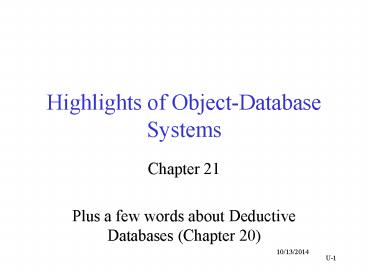U-1 PowerPoint PPT Presentation
1 / 17
Title: U-1
1
Highlights of Object-Database Systems
- Chapter 21
- Plus a few words about Deductive Databases
(Chapter 20)
2
Limitations of the Relational Model
- limited constraints expressible
- limited types of relationships
- normalization leads to atomization, inefficiency
- Limited built-in data types
- No support for complex objects, user-defined
types - BLOBs (binary large objects) are one workaround
3
Pressures on Traditional RDBMSs
- From end-users desire to store and retrieve
non-traditional data - From SW development community desire to
integrate todays languages with DB - By lucky coincidence, both parties converge on OO
as a solution to many problems
4
Evolving End-User Needs
- Complex objects pictures, video, X-Rays, CAD
drawings, sound files, time series, etc. - Unstructured data from heterogeneous sources
document scans, commercial data services, the
Web, etc. - Historical data
- to "mine" for unsuspected value
- versions (for change control)
5
SW Development Community
- SW Development community has come to expect
C/Java environment - class libraries, inheritance
- GUI, event-based programming
- Want to develop DB in the same environment
- COBOL and DB grew up together
- COBOL pioneered the "record" construct
- character-based types
- Poor fit to today's languages like C
6
A Look Back
- Before we look ahead...
- Hierarchical and Network (CODASYL) models were
popular before relational - Network had extremely rich semantics
- Complex relationships directly expressed (no
joins) - Primarily "navigational"
- Custom programs locate data via knowledge of
schema, following pointers - No standardized query languages
7
Object-Oriented Trends
- Trends in OO Programming seem promising for
databases - Rich, user-defined data types
- support of new media
- lift 1NF restriction
- Inheritance (important type of relationship)
- Encapsulation of data and functions
- Increasing emphasis on components and
reusability cross-platform operation - Tighter integration with C, Java
8
ORDBMS vs OODBMS
- Object-relational DBMS (ORDBMS) relational
system with some object features added in - Approach taken by major DB vendors (in different
forms) - Approach taken by SQL evolution
- Object-oriented DBMS (OODBMS)
- More radical rethinking of DBMS
- Tight fit to C or Java
9
Strict OO Viewpoint
- Where possible model the behavior and
relationships of the real world - Everything is an object
- Objects communicate only by passing messages
- In practice, a message is a function name plus a
set of arguments - Types can be determined at run-time
- Smalltalk is the model untyped interpreted
interactive
10
Object Identifiers (OIDs)
- Unique (database-wide) identifier for each object
- similar in concept to a pointer, but is permanent
- independent of key
- One object can reference another via OID
- Allows complex embedding without data duplication
- somewhat similar to use of a foreign key
- Increases referential integrity problems
11
Hybrids and Compromises I
- Coming from a traditional RDBM
- Will retain relational facilities
- Add support for user-defined types
- type constructors
- support for methods
- maybe support for specialized indexes
- Add OIDs and reference objects
- Add inheritance
- Modify existing query language
- SQL3/SQL4 will have OO features
12
Hybrids and Compromises II
- Coming from C/Java
- Add "persistence class objects automatically
saved on disk - Add TP support
- Add a query language
13
Persistence
- The idea it's easy for a program to work with a
complex data structure in memory, but hard to
flatten it into a file. - It would be convenient if some variables were
persistent, i.e., could exist on disk between
executions of the program, i.e., be part of the
DB. - Not strictly on OO concept
- One challenge mapping OIDs between in-memory
pointers and disk addresses - "pointer swizzling"
14
Challenges for Query Languages
- DDL coordinating PL with QL
- Encapsulation issues
- how much is visible?
- must all operations be predefined?
- Multimedia
- what does "query" mean?
- how to display results?
- Typical user must register methods with DBMS
15
OO Wrapup
- Commercial DBMSs are evolving into ORDBMSs
- User-defined ADTs
- Inheritance
- All the old reliable stuff (TP)
- Also coming Web as a DB source
16
Deductive Databases I
- See chapter 20
- Another (non-OO) approach to relieving relational
limitations - Admits recursive queries such as transitive
closures Give me all of Johns ancestors - Excellent at expressing complex constraints,
making deductions and discoveries, etc. - DB viewed as a set of facts and rules
- a row can be viewed as a fact which satisfies a
predicate
17
Deductive Databases II
- Query languages
- Datalog DB extension of Prolog
- Logic-based
- vastly different from SQL
- but curiously, both are non-procedural
- fixpoint v is a fixpoint of a function f if
f(v) v - recognizing and computing fixpoints efficiently
is the heart of recursive query processing - Thorny problem negation
- What part of not dont you understand?

